Introduction
In a world where technology is advancing faster than we could have ever imagined, we are being exposed to new technology and ideas every day. One of these advancements that is being seen more and more world-wide is the use of hybrid and electric vehicles (EV’s) by the average person. As big as this market may seem now, it is only going to keep rising. Many of the world’s largest automotive manufacturers have made claims to shift large portions of their productions towards the world of EV’s.
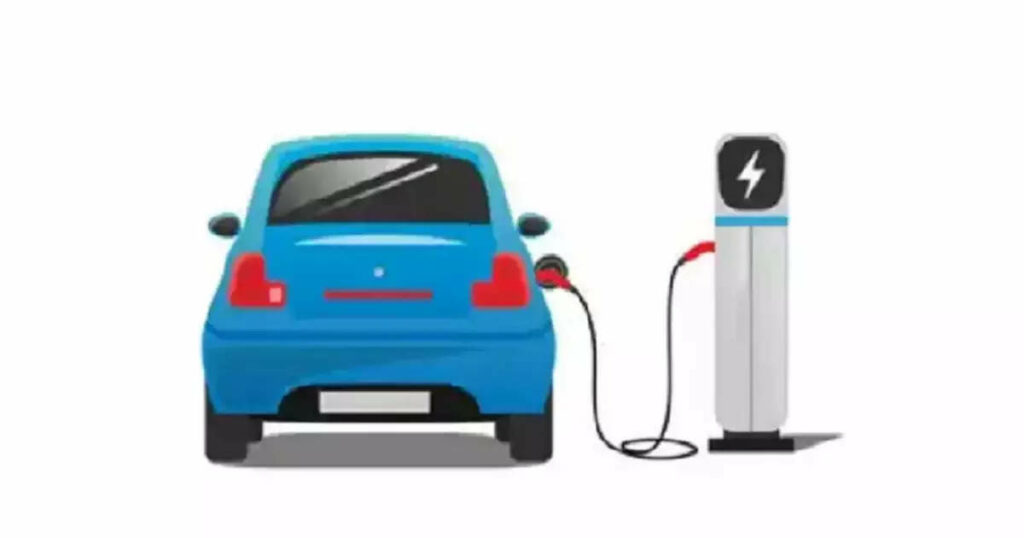
This includes Volkswagen by producing 70 EV models by 2028 and investing $91 billion to EV, Toyota by making half of sales to be EV by 2025, and many more. In theory, the possibility for 100% of car sales to be EV’s is not unlikely. With EV’s being cheaper to repair and maintain, reducing the greenhouse gas and air pollutant emissions that are created by gas-burning vehicles, and the Earth having a limited supply of fuel that will likely be coming to a scarce amount this century, a future without EV dominance is hard to deny.

This new exposure to electric vehicles rises a lot of uncertainty and questions towards EV advancements and ideas as well. A large portion of these questions are having to deal with EV charging. Common questions that people may have based off of charging may include: different kinds of charging methods, where to charge my vehicle when away from home, and charger installation questions in general. With an estimated 52% of all new vehicle sales to be EV in 2030, there will be a very large demand for chargers. This need for chargers will not only be at houses and public charging stations, but also at commercial parking lots and residential complexes. This article will be explaining everything there is to know about installing EV chargers in your building’s parking lot.
Why do you want to install EV chargers in your parking lot?
When it comes to reasons for installing EV chargers in your parking lot, there are many ways for companies to gain benefits of having EV charging installed at your building. Listed below is a description of a few of those ways:
Promote green acknowledgement and responsibility
In this day and age, it is somewhat of an expectation for companies to display that they are conscious of becoming more of a green business and doing their best to reduce their carbon footprint. By installing one or more EV charger, the company can promote the use of EV’s by giving a place for EV drivers to charge their vehicle. This can promote the purchase and use of EV’s by making it known by drivers that there are more than enough places to charge their vehicle, when that’s what so many people fear when debating the purchase of an EV: nowhere to charge! With it being known that this is available at their job site, grocery store, or shopping mall, there will be much less hesitation for purchasing an EV.

Futureproofing
With EV purchase and usage trends increasing regularly, it only makes sense that the EV market will grow. With the EV market growing, the need for charging will also increase, and you will not want to be the only company in town without access to an EV charger to the public. However, installing an EV charger now will give your business the upper hand in offering services and giving exclusive benefits to customers shopping at your business.
Attract customers
By adding an EV charger to your premises, your company will be seen on Google Maps, Apple Maps, or whatever digital map platform someone uses when they search for EV charging. With EV drivers knowing that your business has chargers for their vehicles, it will promote more business. Not only will having EV charging available bring new and more customers, it will also promote your brand’s reputation as one that is conscious and caring of their environment, promoting even more business from shoppers who are also environmentally conscious.

With even the fastest available chargers taking at least 15-20 minutes to charge a car, the driver needs something to do while their car is charging: visiting your business! Installing an EV charger will also keep EV drivers coming back and being a loyal customer. If a person knows that a specific chain has available EV charging, it will likely make them want to visit more often, knowing that there is an available charging option while they are shopping or whatever it is they may be doing.
Source of income
While installing EV chargers may sound quite expensive, there are multiple ways to receive payment for the installation and use of these chargers. One of these ways is fees per use. The business owner can modify their charging stations to their needs and control who pays and how much they pay for the use of the machines, much like a gas pump. An example of this could be employees paying a cheaper rate for that EV charger than someone who is not an employee. This could also be the same case for customers. There could be incentives to having customers use the chargers, such as get a certain amount of money off for each minute of use. There are many options here and they can be discussed within the business.

Tax rebates and incentives
Governments worldwide are trying to create a greener planet in many ways, and one way is by encouraging EV advancements and giving incentives and tax breaks for companies that decided to install EV chargers. These credits can be at a federal, state, or a local level. There are different incentives for every state, with California having the largest EV incentive program for businesses in the U.S., but all are beneficial and can be taken advantage of. More information on incentives will be given later in the article.
EV Charging: Levels of charging
As you likely know, EV’s possible range of distance is dependent on the size and charge of the battery. Bigger batteries will take longer to fully charge, but will allow for a longer distance traveled off of a full battery. That brings up a very common question when dealing with EV charging: How long will it take to fully charge a standard electric vehicle? This depends on the level of charging that you decide to install at your building or business. There are three different levels of EV charging: Level 1, Level 2, and Level 3 (more commonly known as DC Fast Charging). As you move up in the charging levels, the less amount of time it will take to fully charge a battery.
Level 1
Level 1 charging is the most basic form to charge an EV. This is the most accessible type of charging, but it is also the slowest. This type of charging uses AC from the power grid to charge the car battery. This can be done by either plugging in the power cord that came with the EV directly into a standard 110V outlet, or by getting a separate level 1 charger. With this type of charging being most applicable for charging hybrid models of EV’s, a level 1 charger will typically charge a battery with 1-6 miles of range per hour of charging. They also typically charge at 1kW of power. With this speed of charging, it will take roughly 24 hours to fully charge most vehicles, but can also be longer depending on weather conditions, battery size, vehicle conditions, and driving style. It is not very applicable for an office or commercial building, and is intended more for at home use.

Level 2
This type of charging is more commonly found at work places, offices, or residential areas. They are much faster than level 1 chargers and are a bit more costly, being roughly $800 - $2,200 after labor fees. These types of chargers use a 208 - 240V circuit, 30 amp electricity, and use roughly 3kW- 20kW of power (typically 6kW). These installations also typically require an electrician to install. Most level 2 chargers have many “smart” functions, such as touch screen, usage tracking and managing, Wi-Fi connectivity, and many more. This type of charger is roughly 5-15 times faster than level 1 charging, depending on the power output. They tend to add roughly 6-30 miles of range per hour of charge, but this can still fluctuate with vehicle conditions, battery size, etc. With this type of charging, it will typically take around 6-12 hours to fully charge a vehicle, which makes it perfect for workplaces and commercial buildings.
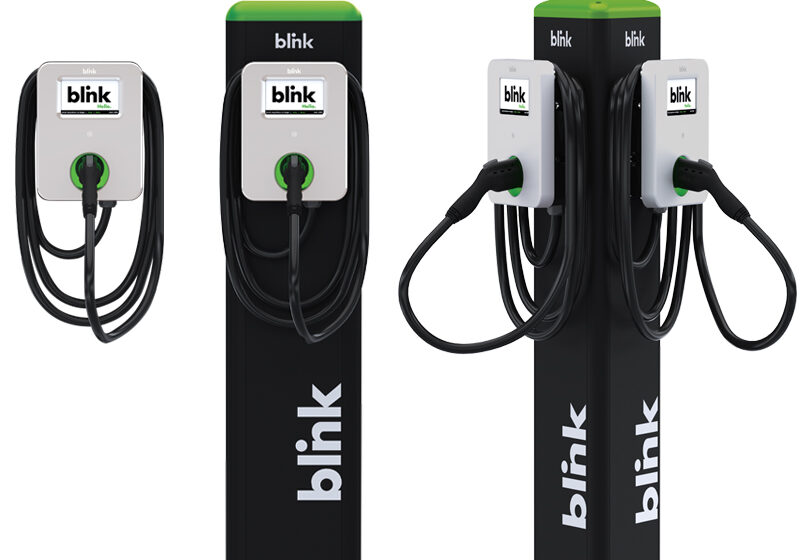
Level 3
Level 3 chargers are the quickest and the most expensive chargers, costing around $40,000 and up. These chargers supply the battery with the DC power directly, which is why they are so expensive. These chargers are mainly used at auto dealerships and roadside charging stations that are made strictly for charging electric vehicles. These use 3-Phase DC electricity, and typically use 50kW-60kW of power. Most will not want to install these at their business or commercial building, simply of how expensive and over the top it is compared to the more cost-effective level 2 charger. The use of these would be optimal where there is a lot of congestion and usage of chargers, so one person can charge their vehicle in an hour and the next person can start charging.

Why level 2 charging is the best option for commercial use
Level 2 charging is the usually best option for commercial use for multiple reasons. For workers, the average work shift is around 8 hours, which is roughly the same amount of time as it would take to fully charge an EV.
Steps to installing EV chargers at your premises
Step 1: Site Analysis
The first step to installing an EV charger in your workplace is to take a good look at your parking lot and determine where you are going to want your EV charging spaces. When thinking about this, there are many things to consider. This usually starts with a discussion within the company of the goals and needs that are wanted to be accomplished with EV charging. What exactly do you want with your EV chargers? Do you want them to be networked? Do you know what level of charging you want? Do you want your parking spots to be EV ready or EV installed? (EV ready means that the design and construction of an EV charging parking space with the necessary conduit, wiring, and any special circuitry required to install your charging station, while EV installed simply means that you have the conduit, wiring, and circuitry installed as well as the physical charger itself, and is ready to start charging vehicles). These and many more are all questions that you are going to want answered. To answer your questions, you are going to want to contact an energy company so you can get more information on your energy grid. Some of the things that you will want to discuss with the energy company is if your electrical infrastructure is adequate (or if it needs an upgrade), where on the property is going to be the ideal spot or spots to install EV charging, and lighting/security requirements. The energy company will be able to provide an answer to all other questions and concerns you may have, and they will guide you through the process of installing EV chargers at your workplace.
needs that are wanted to be accomplished with EV charging. What exactly do you want with your EV chargers? Do you want them to be networked? Do you know what level of charging you want? Do you want your parking spots to be EV ready or EV installed? (EV ready means that the design and construction of an EV charging parking space with the necessary conduit, wiring, and any special circuitry required to install your charging station, while EV installed simply means that you have the conduit, wiring, and circuitry installed as well as the physical charger itself, and is ready to start charging vehicles). These and many more are all questions that you are going to want answered. To answer your questions, you are going to want to contact an energy company so you can get more information on your energy grid. Some of the things that you will want to discuss with the energy company is if your electrical infrastructure is adequate (or if it needs an upgrade), where on the property is going to be the ideal spot or spots to install EV charging, and lighting/security requirements. The energy company will be able to provide an answer to all other questions and concerns you may have, and they will guide you through the process of installing EV chargers at your workplace.
Step 2: Infrastructure Planning
The second step for installing an EV charger is to plan the infrastructure needed for installation. Like mentioned earlier, you are going to want to know if your electric grid supplies enough electricity to supply the charger you desire (likely a level 2 charger), which uses 208/240V electricity. The standard electricity grid in the U.S. is 120V, and if you don’t meet the electrical requirements you need, you will likely have to speak to an electrical contractor to upgrade your electrical grid.

You will also likely have to speak with a landscaping contractor. In order for a parking space to be EV  ready, there must be underground trenching and conduit ran from an electrical box to where the charger will be placed. In circumstances where there is an existing parking lot, the asphalt and concrete is going to need to be torn up, trenched and conduit placed with wiring, and concrete and asphalt re-poured. If the layout of your site allows for running conduit under soft-scape, such as dirt or natural earth, it will be much easier and cost effective to trench where there is no existing asphalt. Just lay the conduit and cover up the trenches with the desired material. In circumstances where you are planning infrastructure for a building that has not been constructed yet, you will definitely want to trench and run your conduit before you lay the asphalt for the parking lot, saving a large amount of money by skipping the asphalt-tearing step.
ready, there must be underground trenching and conduit ran from an electrical box to where the charger will be placed. In circumstances where there is an existing parking lot, the asphalt and concrete is going to need to be torn up, trenched and conduit placed with wiring, and concrete and asphalt re-poured. If the layout of your site allows for running conduit under soft-scape, such as dirt or natural earth, it will be much easier and cost effective to trench where there is no existing asphalt. Just lay the conduit and cover up the trenches with the desired material. In circumstances where you are planning infrastructure for a building that has not been constructed yet, you will definitely want to trench and run your conduit before you lay the asphalt for the parking lot, saving a large amount of money by skipping the asphalt-tearing step.
The process will not only be tearing the asphalt and running conduit, but you must consider the time it takes for concrete and asphalt to settle when it is re-poured. You will also want to consider the time and labor it will take for striping the asphalt and boring holes where this must be done.
This step in the process is also where you will want to be looking into incentives and tax rebates for installing EV equipment. Like mentioned earlier, governments across the world are encouraging companies to become greener by giving incentives to these businesses. Since EV chargers are quite expensive, and you have to deal with the expenses of tearing asphalt, running conduit, pouring new asphalt, and many more small expenditures, getting incentives can drastically reduce the overall cost of installing EV charging equipment. For state by state incentives that may apply to you, see https://afdc.energy.gov/fuels/laws/ELEC. This link can also show you available utility rebates for various companies in your state. You can also speak with your utility companies to discuss potential utility rebates.
installing EV equipment. Like mentioned earlier, governments across the world are encouraging companies to become greener by giving incentives to these businesses. Since EV chargers are quite expensive, and you have to deal with the expenses of tearing asphalt, running conduit, pouring new asphalt, and many more small expenditures, getting incentives can drastically reduce the overall cost of installing EV charging equipment. For state by state incentives that may apply to you, see https://afdc.energy.gov/fuels/laws/ELEC. This link can also show you available utility rebates for various companies in your state. You can also speak with your utility companies to discuss potential utility rebates.
General Site Issues
When planning the infrastructure for your chargers in your parking lot, it is likely that you are going to run into one or more problems. Some of these issues are things that you will want to be thinking about and discussing with your contractors or Energy Company that you have hired for the job:
- Availability of Power: Proximity to/of your charging stations is often a key factor in your plan of attack when installing chargers. Having your chargers installed close to your power supply will save you time and money.
- Construction: You obviously want to tear up as little landscape as possible to save time and money, but if you must (which is quite likely), tearing up areas with soft-scape rather than hard-scape will save lots of time and money. You will also want to think about what type of bollards you are going to want to install. Bollards are great for protecting your expensive charging equipment from potential careless driving and driving mistakes made by charger users when they are pulling up to charge their EV. If you are planning on installing in-ground bollards, you are going to want to make sure that you have that planned before you lay your concrete. If you are not installing in-ground bollards, then you can install bollards where/when you please.
- Mounting: When it comes to mounting your chargers, there are a few things to consider. This all depends on the location of your EV charging spots as well. One thing to consider is the
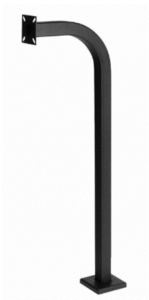 method of mounting your chargers. The most common methods for mounting are either wall-mounting or pedestal-mounting. Wall mounting is exactly how it sounds, and is the cheaper option, but this requires your EV charging spots to be located very close if not against some sort of wall. This also requires the proper voltage outlets to be installed in the walls. The other option is pedestal-mounted chargers. While being more expensive and likely taking a little longer to install, this is not a bad option either. The pedestals that the chargers mount onto will need to be nice and sturdy into the ground, and mountable around four to five feet off the ground. Also, to save money and time on buying and installing a pedestal for every spot, a pedestal can be placed at the front corner of two charging spots and two chargers can be mounted on one singular pedestal. In theory, this could also be done in a corner of four spots. Make sure that the location that the chargers are being mounted are well visible and lit during night and day.
method of mounting your chargers. The most common methods for mounting are either wall-mounting or pedestal-mounting. Wall mounting is exactly how it sounds, and is the cheaper option, but this requires your EV charging spots to be located very close if not against some sort of wall. This also requires the proper voltage outlets to be installed in the walls. The other option is pedestal-mounted chargers. While being more expensive and likely taking a little longer to install, this is not a bad option either. The pedestals that the chargers mount onto will need to be nice and sturdy into the ground, and mountable around four to five feet off the ground. Also, to save money and time on buying and installing a pedestal for every spot, a pedestal can be placed at the front corner of two charging spots and two chargers can be mounted on one singular pedestal. In theory, this could also be done in a corner of four spots. Make sure that the location that the chargers are being mounted are well visible and lit during night and day.
- Protection: When choosing your mounting style and location for your EV charging spot, you are going to want to think about the protection that your chargers will have from the elements. You need to make sure that you are able to remove snow and ice if you live in an area that is
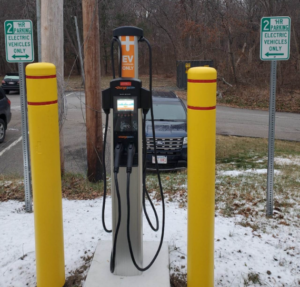 prone to these elements. Also, you are going to want a method of keeping the cord and plug off the ground. Keeping these off the ground will prevent ice and dirt getting in the plug, and potentially damaging your expensive equipment. Many people come about this by purchasing some sort of easily accessible hooks or clip. The best way to keep it safe from the elements would be to have a retractable cord that can become fully enclosed. You also will want to avoid installing EV equipment in areas that are prone to flooding. Like mentioned in the “Construction” section above, sturdy bollards will also help protect your equipment from vehicle-caused damage. Posting signage that displays video-surveillance can also help prevent theft.
prone to these elements. Also, you are going to want a method of keeping the cord and plug off the ground. Keeping these off the ground will prevent ice and dirt getting in the plug, and potentially damaging your expensive equipment. Many people come about this by purchasing some sort of easily accessible hooks or clip. The best way to keep it safe from the elements would be to have a retractable cord that can become fully enclosed. You also will want to avoid installing EV equipment in areas that are prone to flooding. Like mentioned in the “Construction” section above, sturdy bollards will also help protect your equipment from vehicle-caused damage. Posting signage that displays video-surveillance can also help prevent theft.
Step 3: Final Preparations and Installation
In the final steps of installing your EV charger(s), you will want to make sure that you have all documents necessary that will allow you to obtain applicable incentives to reserve funding for your project. This may include filings with the Environmental Protection Agency (EPA), state and local governments, or the utility companies that you are listed with.

Cost
When it comes to cost, there are a few factors that play into the total. These costs are purchase of equipment, installation, operation, and maintenance. All of these, however, can vary. Purchasing equipment depends on what level and kind of charger you would like. A level 1 charger would likely cost under $100, level 2 from $500 - $1,000, and level 3 costing about $15,000 and up. Like mentioned, a level 1 or level 2 charger are quite impractical for a commercial business. Included in the purchase you will likely have to make is the mount for the charger, whether that is a wall mount or a pedestal, and bollards to protect the charger. A wall mount can be purchased for under $100, and bollards can range from around $200 - $1,000.
Then there is the installation cost, which will likely be the majority of your expense. This cost is very dependent on your site, so it can vary widely. These costs depend on if asphalt needs to be torn/poured, trenching, and installation of conduit. This also includes the labor costs of doing both of these.
Operation and maintenance costs will be the smallest chunk out of the total expenses for installing and operating EV chargers. The operational cost will also depend on the level and type of charger that you desire. Included in operational cost is the amount of energy used and if you decide to monitor the charger’s usage. Energy for a level 2 charger can cost anywhere up to around $2,500 a year, depending on how much the charger is being used. Monitoring a level 2 charger costs roughly $250/year per charging port for network and software access. Maintenance includes snow removal (if it applies to your state), keeping the chargers and cords in good shape, and insurance. All of these factors can vary.
Remember, incentives are available for a large portion of purchases. While this cost may seem very high for all of these components, rebates and incentives will greatly reduce this cost.
Installation Cost Chart

Installation Cost Chart
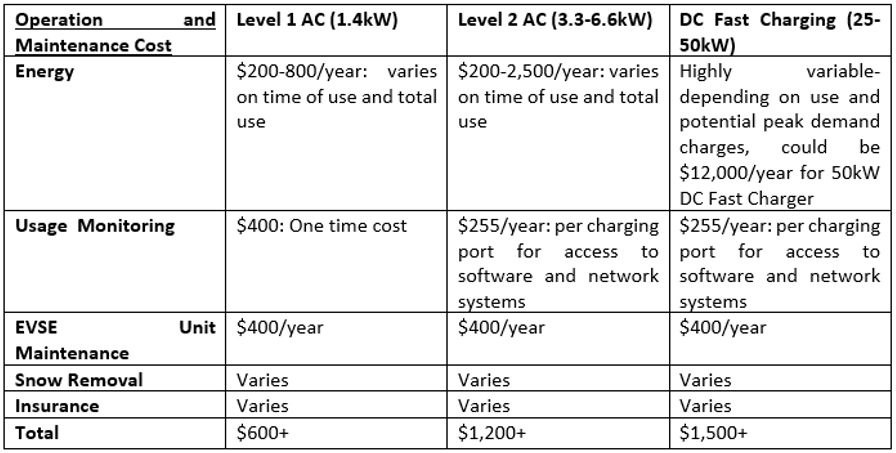
Code for Installation
Green Building Code
Another very large benefit of installing EV charging at your workplace is the LEED (Leadership in Energy and Environmental Design) credits that you will gain for Green Building Standards. If you are unfamiliar with LEED and Green Building Standards, to sum it up, it is a certificate that is looked very highly upon. It is awarded to companies who have multiple aspects of green efficiency, such as using less water and energy, limiting greenhouse gas emissions, and installing EV charging stations. There are, however, different levels to these certificates. There is LEED Certified: 40-49 credits, LEED Silver: 50-59 credits, LEED Gold: 60-69 credits, and LEED Platinum: 70 + credits. More on LEED and the USGBC (U.S. Green Building Council) can be found at https://www.usgbc.org/.

In order to receive a credit for EV charger installation, you must meet the LEED requirements set by the USGBC. There are two options for this:
Option 1: Electric Vehicle Supply Equipment (1 credit)
In order to achieve this credit, you must install electric vehicle supply equipment (EVSE) in 5% of all parking spaces or 2 parking spaces, whichever is greater. They must be clearly identified and reserved for the use of plug-in electric vehicles, provide a Level 2 charging capacity or greater, comply with the relevant regional or local standard for electrical connectors, and meet the connected functionality criteria for ENERGY STAR certified EVSE and be capable of responding to time-of-use market signals.
Option 2: Electric Vehicle Ready Infrastructure (1 credit)
Make 10% of all parking spaces or at least 6 spaces EV ready, whichever is greater. EV ready requirements were explained earlier in this article, under the “Steps to installing an EV charger at your premises” section.
Safety
While installing any type of electrical circuitry, there are codes and standards to follow to ensure safety of the installers, owners, and users. Your energy company will be able to provide all of the information and follow the correct guidelines for installation to make sure everything is done correctly. For a list of state-by-state electricity laws, visit https://afdc.energy.gov/fuels/laws/ELEC?state=mn.
Conclusion
When you are thinking about installing EV chargers at your business, there are many things to think about and consider. In a quick summary, the steps to installing commercial EV chargers are as follows:
- Site Analysis: In this step, you will want to be thinking about what exactly you want from your EV chargers. Look at the area where you plan on installing your chargers, and think about optimal placing. You are going to want to contact an energy company to help you along the way, and answer any questions you may have to get you started.
- Infrastructure Planning: Here is where you will talk to your energy company to find out if your electricity grid will support 208/240V electricity (if you don’t already know). If it is not up to par, you will need to upgrade your power grid then speak to a landscaping contractor in order to be able to lay your conduit. Asphalt/concrete may need to be torn up, trenches dug in the earth, conduit laid, and asphalt/concrete laid back over. You will also want to be looking into tax/utility rebates and incentives during this time.
- Final Preparation and Installation: Once you have your power grid upgraded, conduit laid, and your asphalt poured, you will be EV ready. At this point, you can wait to purchase your chargers until desired, or you can jump the gun and purchase and install your chargers right away to futureproof your business.
After completing these steps, you are finished! A big sigh of relief may be needed, as you have just completed what may seem to be a very long, expensive, and intricate process. This process is made much simpler, however, with a good energy company companion and really diving into rebates and incentives. You should feel very happy with the advancements your company has made by contributing to a greener business, making EV driving customers and employees happier, and futureproofing your business for the undeniable EV dominated years to come.
